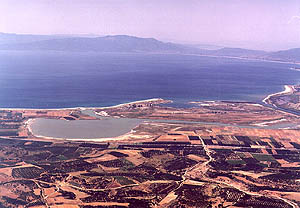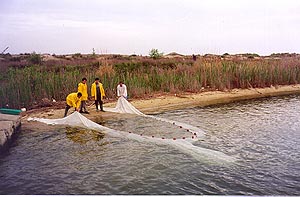|
You are here: /
Practice / Case Study
Introduction
Strymonikos and Ierissos Gulfs, that belongs to 4 prefectures (Kavala, Serres, Thessaloniki, Chalkidiki). The Kavala and Serres Prefectures belong to the East Macedonia & Thrace Region and the Thessaloniki and Chalkidiki Prefectures belong to the Central Macedonia Region, Greece.
The project area covers 1076 km? of which 262 km? land and 813 km? sea. The coastline is 123 km long. The resident population is 15,360, but rises to over 150,000 in summer.
Pollution and environmental damage have increased in recent years and tourism is expected to grow. Authorities are aware of the need for forward planning. However, the implementation of sustainable development is constrained by the complex jurisdictions of the various administrative bodies involved in the development of the area, the fragmented land-use planning and the insufficient environmental awareness at all levels of decision making.
The aim of the project is to demonstrate the benefits of coordinated action for the conservation of coastal zones, by promoting the concerted management of the Strymonikos coastal zone. |

View of the Strymon estuarine system
(photo: Koutrakis E.)
|
Main issues
Human activities in the area include mass tourism, uncontrolled building construction, fisheries, aquaculture, agriculture, forestry and mineral extraction. These activities are not always practised wisely leading to increasing environmental problems, such as pollution and landscape deterioration, which will become far more serious in the next decades, as a result of the expected increase of tourists from the Eastern European countries. Also, mining activities in Chalkidiki are changing and an industry for gold extraction is going to be created in the area, posing additional threats to the environment. The Egnatia highway which will connect the Ionian Sea with Asia is now under construction. Finally, it must be considered that River Strymon may carry pollutants from its Bulgarian and Greek watershed into Strymonikos Gulf.
The area's principal environmental problems are the lack of planning for urban and tourist development, the disposal of domestic sewage and rubbish, the degradation of surface and ground waters, as well as that of natural habitats, the declining fish stocks and, finally, the salt intrusion in the River Strymon.
The main problems for implementing ICZM in the area were:
- the lack of data regarding the natural environment, the socio-economics and the human impacts,
- the complex and conflicting jurisdictions of the bodies presently involved in the management of the area and
- the insufficient level of environmental awareness.
|
Institutional/stakeholder analysis
Institutional settings with respect to ICZM: |
| National level |
Ministry of Environment,
Planning and Public Works
Ministry of Agriculture |
| Regional level |
East Macedonia & Thrace
Region
Central Macedonia Region |
Local
level (municipalities (towns))
|
Kavala Prefecture
Serres Prefecture
Thessaloniki Prefecture
Chalkidiki Prefecture
Agios Georgios |
|
|
Problems encountered
Complex and overlapping or conflicting jurisdiction (roles and responsibilities) of management bodies has been a problem |

Fish sampling: Sampling in the estuarine system of the Strymon river in order to record the fish abundance in the area (photo: Koutrakis E.) |
Designing institutional arrangements for planning and analysis
Besides the Ministry of Environment, Physical Planning and Public Works, other authorities which influence directly or indirectly the formulation of coastal policy are the Ministries of Merchant Marine, Agriculture, Development (Industry, Tourism), National Economy, Defence, Interior, Finance and the Ministry of Health. There is no provision for a mechanism at the national government level that could pursue co-ordination and arbitration, causing as a result several problems. Although from a legislative point of view the potential exists to pursue integrated coastal management, administrative structures are not always up to such a task
Problems encountered
Co-operation and co-ordination between local and sectoral administrations is an issue of multiple conflicts: extraction industries (gold mining)-tourism, urban development-nature conservation, tourism-nature conservation, agriculture-nature conservation, and coastal fishing- pelagic fisheries.
Main achievements
The Steering Committee, which is made up of those Authorities with jurisdiction over the coastal area, including sectorally oriented ministries |
Conflict management
Co-operation and co-ordination between local and sectoral administrations is an issue of multiple conflicts: extraction industries (gold mining)-tourism, urban development-nature conservation, tourism-nature conservation, agriculture-nature conservation, and coastal fishing - trawlers-pelagic fisheries. There was an effort to resolve conficts by bilateral meetings with the presence of the decision makers and when needed with a small study of the problem by an expert. However after the thorough study of the area (abiotic, biotic in the terrestrial and marine part, social, economic and administrative features, etc) it was much more easier to answer to the problems and promote the "correct" solution.
Participation
The objective for participation was to involve as many as possible people in the ICZM process
The environment and economic development stakeholders were involved in the broader group of stakeholders which meets on an annual basis.
Main achievements
A Co-ordination Scheme, involving bodies responsible for the project zone's management (ministries, regions, prefectures, agencies formally involved), is established, which sets protection and management aims, decides on priority measures and coordinates their implementation. This group consists of less than 15 members in order to ensure good co-operation.
A broader group of stakeholders meets on an annual basis. The meetings were organised by the Co-ordination group which also proposed the representatives of all economic and environmental activities that should be involved.
The project includes environmental awareness activities, such as publication and distribution of awareness material, organization of conferences on concerted sustainable management of coastal zones, presentation of the project and of the EU policy regarding the sustainable use of coastal zone resources, media work etc.
Problems encountered
Convincing decision makers for the need of a Co-ordination Scheme for the management of the project coastal zone. |
Conclusions
A preliminary management plan, including the description of the project area, has been prepared, regarding sites, habitats and species and it was delivered to all parties involved.
The establishement of the Information Centre.
Proposals have been made for the area and for implementation on the national level.
The informal Steering Committee has stopped the meetings because of lack of legal framework. However, the Information Centre, in order to ensure its operation after the end of the project, with all its equipment was granted to the local authorities. Its activities are continued and the attraction of visitors provides an additional income to the local community.
Efforts are currently made to ensure legal and management measures in order to ensure a follow up. The Steering Committee keeps contacts with all goups involved, keeps them informed on what is going on in the area and with ICZM in EU and to tries to find fundings for the emerging issues.
In order to have a follow-up of the project a legal framework for ICZM is needed, a Management Scheme legally binding and a complete management plan.
Lessons learned
Good knowledge of the environmental, social, economic and administrative features of the area to be managed is the first essential step in planning integrated management and sustainable development, while continuous monitoring is necessary to detect environmental changes.
Coordination in the form of a legally based management body is indispensable for the implementation of ICZM. The multi-agency partnership of the Steering Committee used in the Strymonikos project, was just an example for the good operation of a coordination management scheme, since it was informal.
The deficiencies in legislation will pose substantial obstacles to concerted management of the area.
Only a legal binding, either in the form of a directive (e.g. 92/43/EU, 79/409/EU) or of an engagement for the implementation of conventions (e.g. Barcelona Convention), or at a national level can promote sustainable management and environmental protection.
The Information Centre, that was created in the area, has been proven a very useful tool for supporting actions of environmental awareness raising, training, dissemination of information, and for promoting participation of the public and local authorities as well. |
Further information
Dr. Emmanuil KOUTRAKIS
FISHERIES RESEARCH INSTITUTE
National Agricultural Research Foundation
640 07 Nea Peramos, Kavala, Greece
Tel: +30 594 22691-3, Fax: +30 594 22222
Email: fri@otenet.gr, koutrman@otenet.gr
and
Dr. Thalia Lazaridou
GREEK BIOTOPE/WETLAND CENTRE
Goulandris Natural History Museum
14th Km Thessaloniki - Mihaniona
57001 Thermi, Thessaloniki, Greece
Tel: +30 31 473320, 473432, Fax: +30 31 475694 Email: thalia@ekby.gr |

|
|